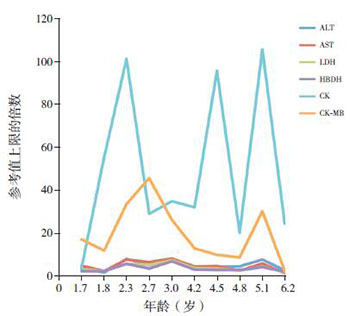 PDF(1910 KB)
PDF(1910 KB)


 PDF(1910 KB)
PDF(1910 KB)
 PDF(1910 KB)
PDF(1910 KB)
6例杜氏肌营养不良回顾性分析
A retrospective analysis of 6 children with Duchenne muscular dystrophy
目的 分析6例杜氏肌营养不良(DMD)患儿的临床特点,并结合文献复习,为早期诊断该病及采取有效治疗措施进行归纳总结。方法 收集2010年1月至2015年10月收治的6例DMD患儿的临床资料,进行回顾性分析。结果 6例均为男性,确诊年龄1.2~11.5岁,均无家族史。起病隐匿,均有谷丙转氨酶、谷草转氨酶、乳酸脱氢酶、α-羟丁酸脱氢酶、肌酸激酶、肌酸激酶同工酶同步升高,以肌酸激酶升高最显著、为正常的3.7~107.2倍。基因检测均提示DMD基因突变;其中2例患儿的母亲行基因检测,提示携带相同突变基因。1例行肌肉活检,病理结果符合DMD改变。1例患儿行脐血间充质干细胞移植,5 d后肌酸激酶下降77.0%。结论 对血清肌酶异常、运动功能异常的男童,应高度警惕DMD,尽早行CK及基因检测确诊,尽早干预,保护尚存的正常肌纤维,延缓疾病进展。
Objective To analyze the clinical features of 6 children with Duchenne muscular dystrophy (DMD) and review related literature, and to provide a basis for early diagnosis and effective treatment of this disease. Methods A retrospective analysis was performed on the clinical data of 6 children with DMD who were admitted to the First Affiliated Hospital of Nanjing Medical University from January 2010 to October 2015. Results All the 6 cases were boys without a family history of DMD, and the age of diagnosis of DMD was 1.2-11.5 years. All patients had insidious onset and increases in alanine aminotransferase, aspartate aminotransferase, lactate dehydrogenase, α-hydroxybutyrate dehydrogenase, creatine kinase (CK), and creatine kinase-MB, particularly CK, which was 3.3-107.2 times the normal level. Their gene detection results all showed DMD gene mutation. The gene detection results of two children's mothers showed that they carried the same mutant gene. The muscle biopsy in one case showed that the pathological changes confirmed the diagnosis of DMD. The level of CK in one case declined by 77.0% 5 days after umbilical cord blood mesenchymal stem cell transplantation. Conclusions For boys with abnormal serum enzyme levels and motor function, DMD should be highly suspected. It should be confirmed by CK and DMD gene detection as soon as possible. And the progression of the disease could be delayed by early intervention for protecting the remaining normal muscle fibers.

杜氏肌营养不良 / 肌酸激酶 / 脐血间充质干细胞移植 / 早期诊断 / 儿童
Duchenne muscular dystrophy / Creatine kinase / Umbilical cord blood mesenchymal stem cell transplantation / Early diagnosis / Child
[1] Mendell JR, Shilling C, Leslie ND, et al. Evidence-based path to newborn screening for Duchenne muscular dystrophy[J]. Ann Neurol, 2012, 71(3):304-313.
[2] Ciafaloni E, Fox DJ, Pandya S, et al. Delayed diagnosis in Duchenne muscular dystrophy:data from the Muscular Dystrophy Surveillance, Tracking, and Research Network (MD STARnet)[J]. J Pediatr, 2009, 155(3):380-385.
[3] van Ruiten HJ, Straub V, Bushby K, et al. Improving recognition of Duchenne muscular dystrophy:a retrospective case note review[J]. Arch Dis Child, 2014, 99(12):1074-1077.
[4] McMillan HJ, Gregas M, Darras BT, et al. Serum transaminase levels in boys with Duchenne and Becker muscular dystrophy[J]. Pediatrics, 2011, 127(1):e132-136.
[5] 李素华, 陈益平, 陈均亚, 等. 进行性肌营养不良误诊为慢性肝炎5例[J]. 实用医学杂志, 2007, 23(1):126.
[6] 刘平, 吴惧, 胡文广, 等. 儿童进行性肌营养不良误诊为病毒性肝炎五例临床分析[J]. 临床误诊误治, 2012, 25(7):40-42.
[7] Brancaccio P, Lippi G, Maffulli N. Biochemical markers of muscular damage[J]. Clin Chem Lab Med, 2010, 48(6):757-767.
[8] Kyriakides T, Angelini C, Schaefer J, et al. EFNS guidelines on the diagnostic approach to pauci- or asymptomatic hyperCKemia[J]. Eur J Neurol, 2010, 17(6):767-773.
[9] 毛冰, 熊晖, 焦辉, 等. 肌酶分析在儿童肌病性高肌酸激酶血症鉴别诊断中的意义[J]. 北京大学学报(医学版), 2014, 46(1):130-137.
[10] Bushby K, Finkel R, Birnkrant DJ, et al. Diagnosis and management of Duchenne muscular dystrophy, part 1:diagnosis, and pharmacological and psychosocial management[J]. Lancet Neurol, 2010, 9(1):77-93.
[11] Bushby K, Finkel R, Birnkrant DJ, et al. Diagnosis and management of Duchenne muscular dystrophy, part 2:implementation of multidisciplinary care[J]. Lancet Neurol, 2010, 9(2):177-189.
[12] Blake DJ, Weir A, Newey SE, et al. Function and genetics of dystrophin and dystrophin-related proteins in muscle[J]. Physiol Rev, 2002, 82(2):291-329.
[13] Takeshima Y, Yagi M, Okizuka Y, et al. Mutation spectrum of the dystrophin gene in 442 Duchenne/Becker muscular dystrophy cases from one Japanese referral center[J]. J Hum Genet, 2010, 55(6):379-388.
[14] 张媛媛, 刘晓亮, 何蓉, 等. 多重连接依赖探针扩增在假肥大型肌营养不良症家系基因诊断中的应用[J]. 中华医学遗传学杂志, 2014, 31(3):338-343.
[15] GoemansN, Buyse G. Current treatment and management of dystrophinopathies[J]. Curr Treat Options Neurol, 2014, 16(5):287.
[16] Bonfanti C, Rossi G, Tedesco FS, et al. PW1/Peg3 expression regulates key properties that determine mesoangioblast stem cell competence[J]. Nat Commun, 2015, 6:6364.
[17] Seto JT, Bengtsson NE, Chamberlain JS. Therapy of genetic disorders-novel therapies for Duchenne muscular dystrophy[J]. Curr Pediatr Rep, 2014, 2(2):102-112.
[18] Guiraud S, Squire SE, Edwards B, et al. Second-generation compound for the modulation of utrophin in the therapy of DMD[J]. Hum Mol Genet, 2015, 24(15):4212-4224.
[19] Scully MA, Pandya S, Moxley RT. Review of Phase II and Phase III clinical trials for Duchenne muscular dystrophy[J]. Expert Opinion Orphan Drugs, 2013, 1(1):33-46.
[20] Bushby K, Finkel R, Wong B, et al. Ataluren treatment of patients with nonsense mutation dystrophinopathy[J]. Muscle Nerve, 2014, 50(4):477-487.
[21] Nakamura A. X-linked dilated cardiomyopathy:A cardiospecific phenotype of dystrophinnopathy[J]. Pharmaceuticals, 2015, 8(2):303-320.
[22] Flanigan KM. Duchenne and Becker muscular dystrophies[J]. Neurol Clin, 2014, 32(3):671-688.
[23] Merlini L, Gennari M, Malaspina E, et al. Early corticosteroid treatment in 4 Duchenne muscular dystrophy patients:14-year follow-up[J]. Muscle Nerve, 2012, 45(6):796-802.
国家自然科学基金(81170661);国家自然科学基金青年项目(81300023,81300977);江苏省自然科学基金青年项目(BK20131020);南京大学中央高校经费(021414340267)。